Table of content
Lymphedema pumps, or pneumatic compression therapy devices, are valuable for managing lymphedema and edema. These devices apply sequential pressure to help the lymphatic system move fluid from swollen areas, providing significant relief for patients with lymphedema in the arms or legs. However, like any medical treatment, Lymphedema Pump side effects do exist, but proper management reduces the probability of these side effects such as Lymphedema leg pump side effects may appear due to wearing incorrect garment sizes, or applying high pressure right from the beginning, instead of starting with less pressure and then moving towards a gradual increase.
Lymphedema Pumps and How They Work
It’s important to understand how lymphedema pumps function before discussing the lymphedema side effects and its prevention.
A lymphedema pump is a medical device that uses intermittent pneumatic compression to move lymph fluid from your arms, legs, or trunk. These devices help in proper lymphatic circulation. The pump consists of inflatable sleeves with a variation of 4 to 8 chambers that apply pressure in a controlled sequence.
Common Uses of Lymphedema Pumps
- Primary and secondary lymphedema
- Post-cancer surgery swelling (e.g., breast cancer-related lymphedema)
- Chronic venous insufficiency
- Lipedema and post-surgical edema
While effective, these devices must be used properly to avoid adverse effects.
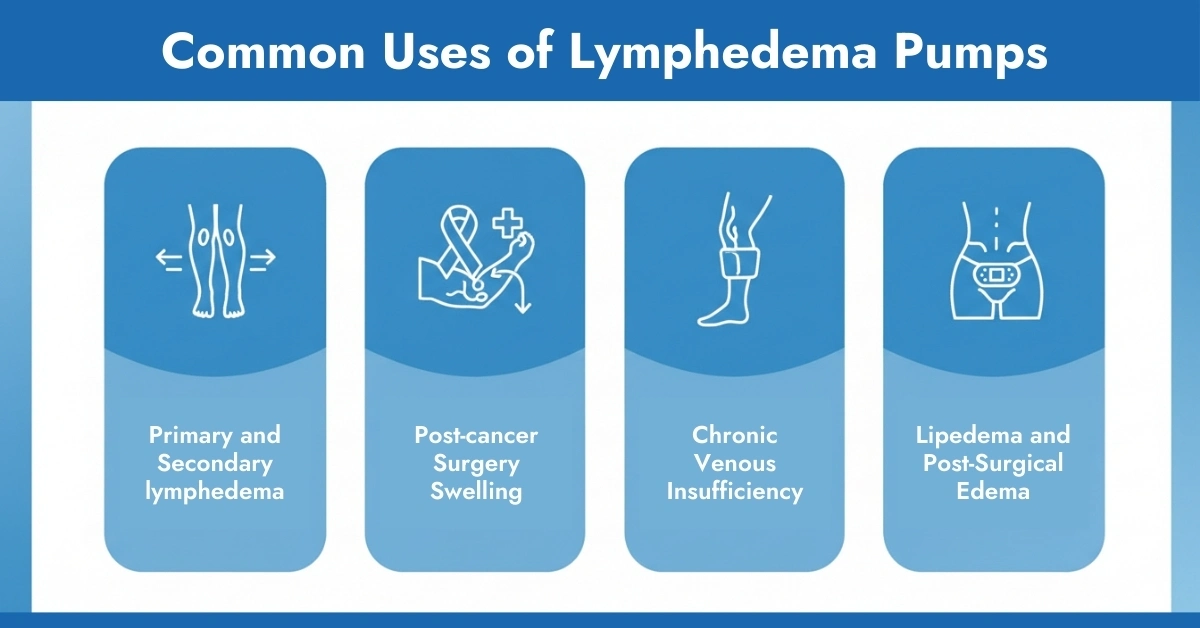
Common Lymphedema Pump Side Effects
Some of the lymphatic massage side effects are as follows;
1. Skin Irritation
This is a common side effect and occurs when the device comes into prolonged contact with the skin, prolonged use, especially if the area isn’t properly cleaned or if the pressure settings are too high.
Solution: This irritation can be alleviated by regularly moisturizing the skin with the best lotion for lymphedema legs and cleaning the affected area before and after using the pump.
2. Discomfort and Pain
A common issue that patients may experience is discomfort, especially during or immediately after the use of the pneumatic garments. This can result from pressure being too high, improper fitting of the device or improperly fitted sleeves.
Solution: Monitoring pressure settings and adjusting the duration of treatment can significantly reduce this discomfort. The important point you must consider is that “Pain is not a normal outcome during processs and should not be ignored.” Always consult with a healthcare provider if you experience such that.
3. Forefoot Oedema and Lymphedema
This is rare, but it can occur if the pump applies uneven pressure or if the area is not appropriately targeted. Proper fitting of the device and consistent pressure adjustments can minimize this risk.
4. Allergic Skin Reaction
While very rare, some patients may experience an allergic reaction to the materials in the pump sleeve or cuff. Switching to hypoallergenic materials can help address this concern.
5. Bacterial and Fungal Infections
Though very rare, bacterial or fungal infections may occur if the pump sleeve is not cleaned or dried properly. It’s essential to maintain proper hygiene and regularly inspect the pump for any signs of infection.
6. Temporary Increase in Swelling
In some cases, swelling may worsen initially, especially if fluid is pushed into untreated areas such as the groin, abdomen, or trunk.
This side effect is more common with:
- Non-programmable pumps
- Inadequate lymphatic pathways
- Lack of manual lymph drainage before pump use
Did you know?
CGM Monitors deals and delivers the market’s topmost Diabetic supplies to your door with no delivery costs (within the USA). And now we bring you the Bio Compression Pumps. Check your eligibility for the Pneumatic compression pump now and leave the rest on us.
Severe But Less Common Lymphedema Pump Side Effects
These severe side effects are very rare but can have serious consequences if they occur:
1. Soft Tissue Damage or Necrosis
This is a very rare complication where excessive pressure causes harm to soft tissues, potentially leading to tissue death. This can be prevented by ensuring the pressure is adjusted appropriately and that the pump is used as prescribed.
2. Nerve Damage
Also very rare, nerve damage can occur if the pump applies pressure to certain areas for too long. Patients should monitor for symptoms like tingling or numbness and report any unusual sensations to their healthcare provider.
3. Arterial Impairment
This very rare issue may arise if pressure is applied too forcefully, affecting blood flow to the arteries. Using the pump as directed and avoiding excessive pressure can prevent this risk.
4. Venous Thromboembolism
Although very rare, venous thromboembolism (VTE), which includes conditions like deep vein thrombosis (DVT), can occur if the pressure interferes with normal venous return. Regular monitoring and appropriate pressure settings are key to preventing this severe side effect.
5. Cardiac Decompensation
This is very rare but could occur if the pump causes a sudden increase in fluid movement, which might put strain on the heart. Patients with pre-existing heart conditions should consult their doctor before using the pump.
6. Genital or Truncal Swelling
Improper lymph fluid movement may lead to swelling in unintended areas, especially when the pump does not support proximal drainage.
This side effect highlights the importance of advanced, programmable lymphedema pumps designed for complete lymphatic flow.
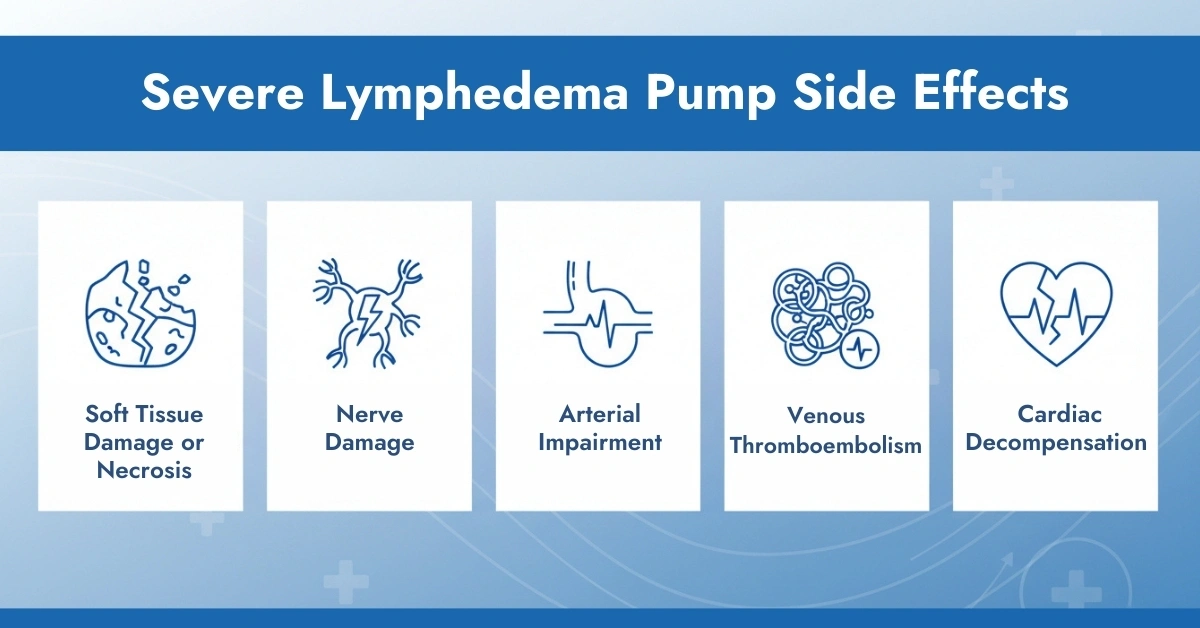
Who Is at Higher Risk?
Certain individuals should use lymphedema pumps with extra caution or avoid them altogether.
High-risk groups that are affected by lymphedema pump side effects include:
- Patients with congestive heart failure.
- Patient with both diabetes and lymphedema.
- Those with active infections.
- Individuals with arterial disease.
- Patients with untreated DVT.
- People with damaged or fragile skin.
Minimize Lymphedema Pump Side Effects: Prevention and Management
The good news is that most side effects are preventable with proper guidance and use.
- Monitor Pressure Settings: Regularly consult with your healthcare provider to ensure that the pressure settings are appropriate and not too high.
- Use as Directed: Follow the recommended frequency and duration of use. Overuse or incorrect use can lead to more severe side effects.
- Skin Care: Regularly moisturise the skin with the best lotion for lymphedema legs to prevent irritation and dryness. Always clean the pump sleeve to reduce the risk of bacterial or fungal infections.
- Frequent Inspections: Check for any signs of discomfort, pain, or skin damage. Adjust treatment accordingly and report any issues to your doctor.
- Diabetes and Lymphedema: When diabetes and lymphedema occur together in the same patient, care must be extra cautious, Here the some extra points that must be considered
Get Coordinated Medical Care – Patients should not treat these conditions separately. It means the patient should be treated with both conditions simultaneously with proper care by a Primary care physician or an endocrinologist.
Maintain Tight Blood Sugar Control – Uncontrolled diabetes makes lymphedema worse. High Blood sugar slows the lymphatic flow, weakens the immune response, delays wound healing and increases the risk of cellulitis. Monitoring blood glucose regularly with a Dexcom G7 CGM sensor is key.
Use Compression Therapy Carefully – Compression is essential for lymphedema, but diabetic patients must use it cautiously. It is recommended to use only medically prescribed compression, avoid excessive pressure, ensure proper fitting, and monitor for numbness, tingling, or discolouration.
Benefits of Lymphedema Pumps: Despite Side Effects
Despite these potential side effects, the benefits of lymphedema pumps generally outweigh the risks. The primary benefit of a pneumatic compression pump is the reduction of swelling in affected areas, improving both physical comfort and quality of life. By enhancing lymphatic drainage and reducing fluid accumulation, pumps help with mobility and reduce the reliance on more invasive treatments.
- Reduces swelling and promotes lymphatic fluid movement.
- Improves circulation and reduces discomfort.
- Available for various body parts, including arms, legs, and abdomen.
- Customizable and adjustable to fit all patients.
Conclusion
Lymphedema pumps offer numerous benefits for lymphedema and edema patients, particularly in the USA, where these devices are becoming increasingly popular. While there are potential side effects, most of them can be mitigated through proper use and consultation with healthcare providers. The benefits of reduced swelling, improved circulation, and enhanced quality of life make lymphedema pumps a valuable tool in the management of these conditions.
Disclaimer: It’s important to follow proper guidelines to ensure safety and optimal results.
Frequently Asked Questions
Is a lymphedema pump painful to use?
Lymphedema pumps are generally not painful when used correctly with appropriate pressure settings. Some users may feel mild discomfort, but sharp or intense pain indicates the pressure should be lowered or that you should consult your therapist.
How can I minimize the risk of skin irritation from my lymphedema pump?
Always wear a thin cotton liner or clothing under the pump sleeve to avoid direct skin contact. Perform daily skin checks, moisturize regularly, and ensure proper fit and moderate pressure to prevent redness or rubbing.
How do I know if my lymphedema pump side effects are serious enough to call a doctor?
Contact your doctor immediately if you experience severe pain, bruising, new open wounds, redness or warmth suggesting infection, or increased swelling near the trunk. Mild discomfort or temporary redness is common, but persistent or worsening symptoms need prompt evaluation.
How can I differentiate between a normal pump sensation and an adverse reaction?
Normal sensations include gentle squeezing, tightness, or mild tingling that resolves shortly after use. Adverse reactions include sharp pain, numbness, persistent bruising, skin breakdown, or worsening swelling—stop use and seek medical advice.
What are the common side effects of using a lymphedema pump?
Common side effects include mild skin irritation, temporary discomfort, and occasional bruising due to excessive pressure. Rarely, users may notice increased urination or genital swelling with lower-limb use. Most side effects are preventable with proper technique.
When is it safe to increase the pressure on my lymphedema pump?
Pressure should only be increased under the guidance of a lymphedema therapist once swelling decreases and current settings are well tolerated. Higher pressure is not always better—starting low (around 40 mmHg) helps prevent complications.
Who should not use a lymphedema pump due to potential side effects or contraindications?
Lymphedema pumps should be avoided in cases of acute deep vein thrombosis, active infection, severe arterial disease, or congestive heart failure. Always consult a doctor if you have open wounds, recent grafts, or uncontrolled cardiac conditions.
How can I prevent lymphedema pump complications?
Follow your therapist’s prescribed pressure, duration, and technique. Combine pump therapy with manual lymphatic drainage and compression garments. Regular skin monitoring, good hygiene, and reporting unusual symptoms help prevent complications.
Are there any long-term side effects associated with lymphedema pump use?
Long-term use is generally safe when properly managed, with no major side effects. Rare issues such as fibrosis are uncommon, and consistent correct use often improves tissue elasticity and helps prevent lymphedema progression.
When should I adjust the settings on my lymphedema pump to avoid side effects?
Settings should be reviewed if you experience pain, skin irritation, or poor swelling reduction. Adjustments should be made in consultation with your therapist rather than independently to ensure safe and effective treatment.
Why does my arm swell more after using a lymphedema pump sometimes?
Temporary increased swelling may occur if pressure is too high, pushing fluid toward the trunk without adequate drainage. Performing manual lymphatic drainage first, using lower pressures, and wearing compression garments afterward can help.
Why is it important to follow my therapist’s instructions for pump pressure?
Therapist-guided pressure ensures effective fluid movement while protecting fragile lymphatic vessels. Excessive pressure can worsen swelling, cause bruising, or promote fibrosis, making professional guidance essential for long-term safety.

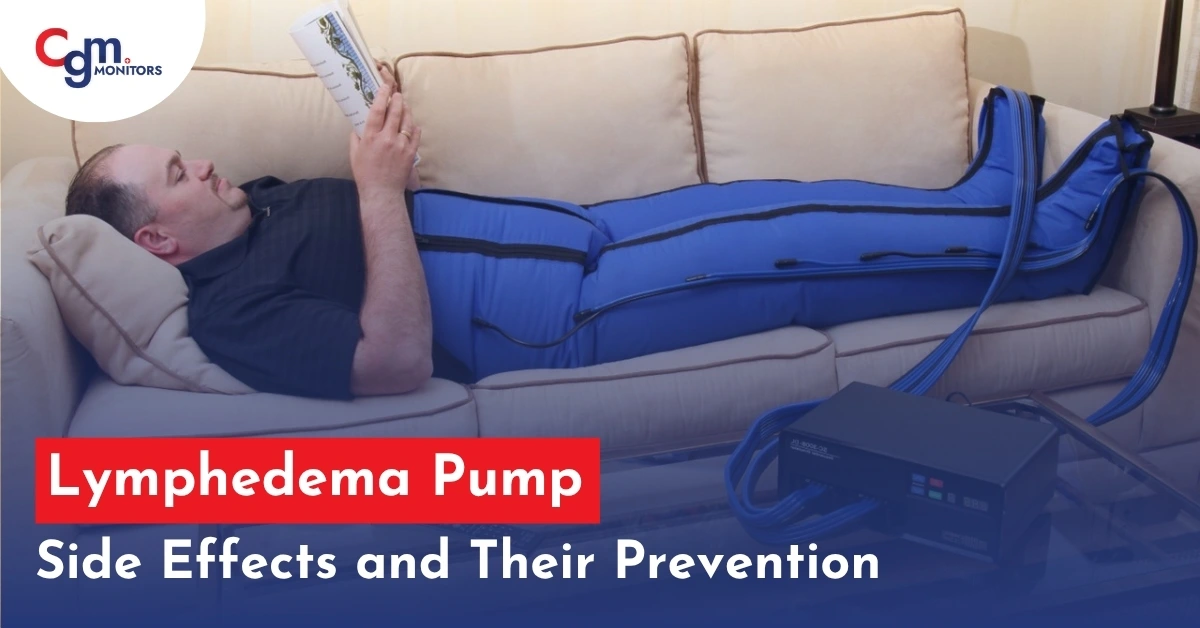
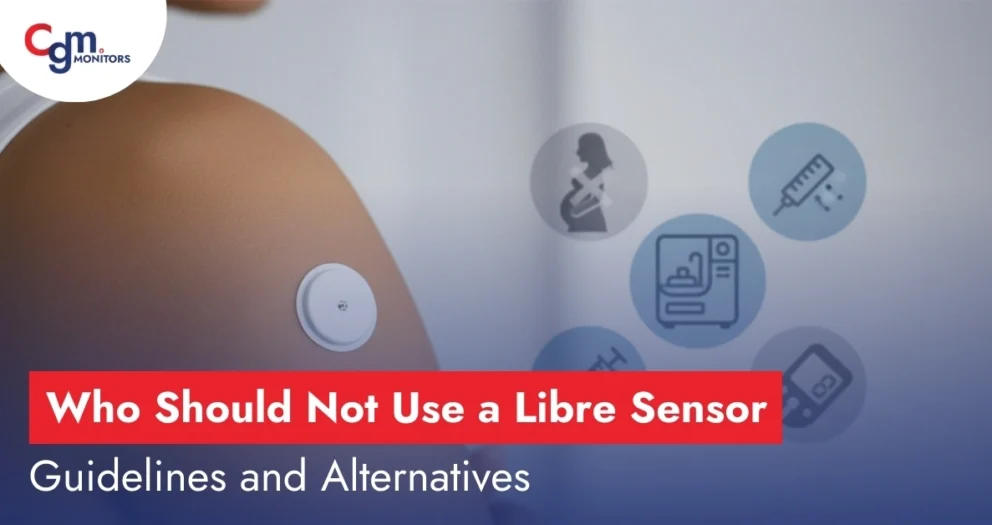



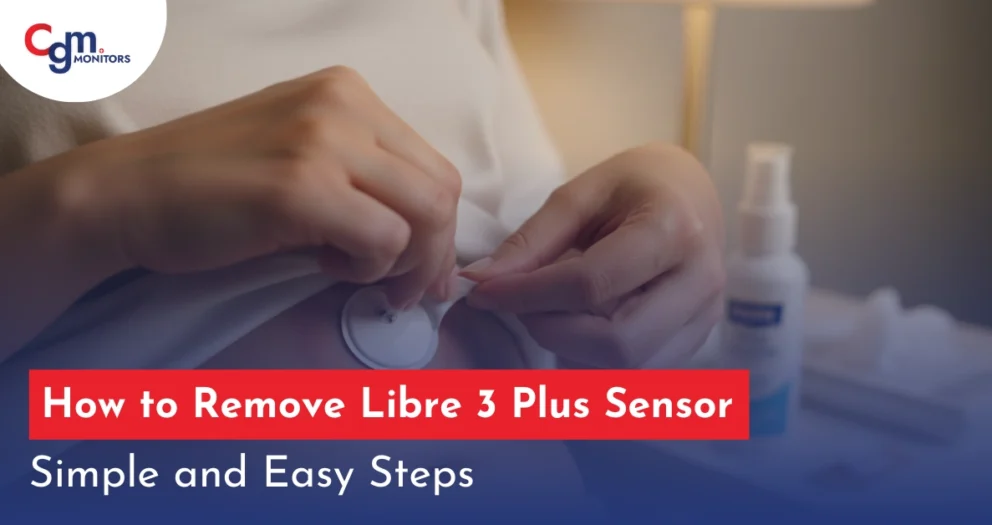
Write a comment
Your email address will not be published. All fields are required